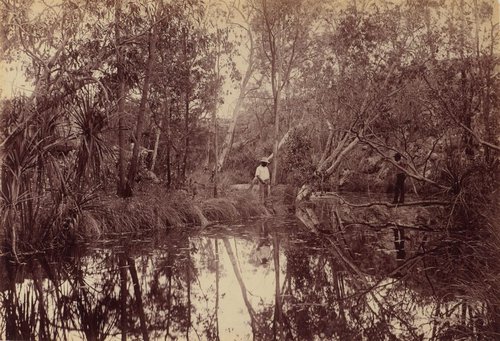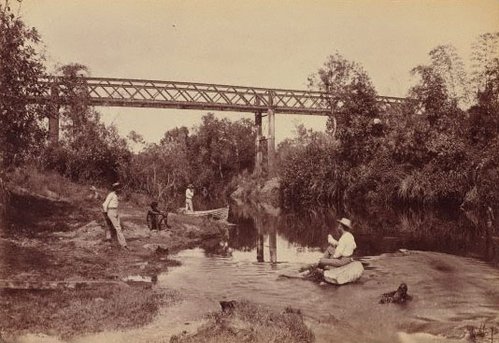Title
(A) Portrait of a woman, Alligator River, aged 33 years 1880s (B) Portrait of a woman, Alligator River, aged 36 years years 1880s (C) Portrait of 'Almarara', Point Essington and Malay Bay, Iwaidja NT, aged 7 years November 1877 (D) Portrait of a girl, Alligator River, Bunitj NT, aged 15 years, 1880s
1880s
1880s
1877
1880s
Artist
-
Details
- Dates
- 1880s
1880s
1877
1880s - Media category
- Photograph
- Materials used
- 4 gelatin silver photographs
- Dimensions
- 4 photographs; each 15.2 x 10.2 cm image/sheet; 21.8 x 28.4 cm original card
- Signature & date
Not signed. Not dated.
- Credit
- Purchased 1986
- Location
- Not on display
- Accession number
- 16.1986.2.a-d
- Copyright
- Unable to display image due to cultural restrictions
- Artist information
-
Paul Foelsche
Works in the collection
- Share
-
-
About
Foelsche was the Northern Territory’s first police inspector from 1870 to 1904. Unlike J W Lindt, Foelsche was not a professional photographer, however he worked assiduously to master the young medium, using it for town and country views as well as to document the Larrakia, Djerimanga, Iwaidja and other Aboriginal groups that the colonists were displacing. The two girls depicted in these photographs are from what Foelsche called the ‘Alligator river tribes’; that is, the country through which the East, South and West Alligator rivers flow from the territory coast more than 100 kilometres inland. As an amateur anthropologist, Foelsche took hundreds of portraits and wrote about the customs and lifestyles of the various Aboriginal groups. Anthropology was a new field and Foelsche an enthusiastic devotee, collecting artefacts for the South Australian Museum and presenting papers at the Royal Society of South Australia.
Foelsche had a small studio next to his house in Palmerston (now Darwin) and there he set up a chair and a plain backdrop. While there is some conjecture as to whether he also photographed his subjects in Fannie Bay Gaol, it is likely that his studio was most commonly used due to the technological constraints of photography at the time. Foelsche printed all his photographs himself, but as a public servant it was not appropriate for him to sell his work. He did, however, send his photographs to international exhibitions and presented albums to friends and important visitors. After his retirement, Foelsche wrote: ‘This is an old country with old people. The new people must remember the claims of the old people. They were here first, and they have their established customs and institutions. So far as those customs and institutions can be related to our standards, they must be respected.’1 However, it is also true that Foelsche was accused of heavy-handedness in his career as a police officer, both early on in South Australia and subsequently in the Northern Territory.
1. Downer S 1963, 'Patrol indefinite: the Northern Territory police force', Rigby, Adelaide
© Art Gallery of New South Wales Photography Collection Handbook, 2007
-
Exhibition history
Shown in 5 exhibitions
Works from the Photography Collection, Art Gallery of New South Wales, Sydney, 10 Feb 1989–15 May 1989
Portraits of Oceania, Art Gallery of New South Wales, Sydney, 27 Aug 1997–26 Oct 1997
Mirror with a Memory: The Photographic Portrait in Australia, National Portrait Gallery [Old Parliament House], Canberra, 03 Mar 2000–11 Jun 2000
What's in a face? aspects of portrait photography, Art Gallery of New South Wales, Sydney, 24 Sep 2011–05 Feb 2012
The photograph and Australia, Art Gallery of New South Wales, Sydney, 21 Mar 2015–08 Jun 2015
-
Bibliography
Referenced in 4 publications
-
Judy Annear, Photography: Art Gallery of New South Wales Collection, 'The photograph and portraiture', pg.15-31, Sydney, 2007, 24 (illus.). reproduction of parts C and D
-
Judy Annear, Portraits of Oceania, Sydney, 1997, 45 (illus.), 46 (illus.). cat.no. 39, part 2c; cat.no. 43, part 2d
-
Judy Annear, The photograph and Australia, Sydney, Jun 2015, 78 (colour illus.).
-
Helen Ennis and Geoffrey Batchen, Mirror with a memory: Photographic portraiture in Australia, Parkes, 2000. no catalogue numbers
-



